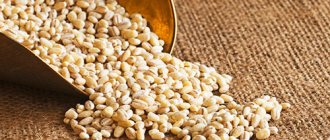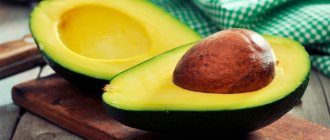A nursing mother carefully monitors her diet while breastfeeding. After all, a woman’s menu directly affects the well-being and health of her baby. In the first six months, the newborn’s body adapts to new conditions. During this period, he is still very weak, so sometimes he reacts negatively to new food.
As a result of the mother's consumption of certain foods, the baby may develop a rash and redness, an allergic runny nose and cough, colic and other stomach disorders. To avoid trouble, it is important to follow a feeding diet and correctly introduce new foods into the diet. Read more about this in the article “Nutrition after childbirth.”
Cottage cheese is a healthy and nutritious product. It contains a lot of useful elements and vitamins that are necessary for the baby and mother. However, can a nursing mother have cottage cheese?
Cottage cheese for a nursing mother
What kind of cottage cheese a nursing mother should eat depends on the form in which it is planned to be consumed. For preparing various dishes - baked goods and casseroles, low-fat cottage cheese (from 1 to 4%) is more suitable. For consumption in its pure form, a high-fat product is preferable, but in limited quantities. Calcium from fatty cottage cheese is absorbed better.
Zero-fat dairy products are optimal for overweight mothers who are trying to lose weight after childbirth. Women with a normal build are better off eating full-fat dairy products.
During the first month of pregnancy, cottage cheese can be consumed by a nursing mother, starting with a small amount and gradually increasing it to the daily norm.
It is important to remember: cottage cheese for nursing should not contain additives or fillers. Curds and especially curd products, curd mass with berries, jams, candied fruits and fruits, chocolate chips can cause allergies in a baby. During lactation there is no need to consume these products - only pure cottage cheese (soft, grainy, pressed). It is recommended to consume cottage cheese with sour cream starting from the third month.
In its pure form, cottage cheese for breastfeeding is recommended in the amount of 100–160 g per day.
Cottage cheese recipes for nursing mothers
If a woman does not like the taste of pure cottage cheese, she can cook different dishes with it, for example, cheesecakes, cottage cheese, casseroles.
Sweet curd mass
Ingredients
- 250 g cottage cheese;
- 1.5 tablespoons of sour cream;
- a quarter glass of sugar;
- 40 g butter;
- vanilla sugar and salt to taste.
Cooking step by step
- Soften the butter and beat until fluffy. Add salt, sugar, vanilla sugar, mix everything.
- Rub the cottage cheese through a sieve and combine with sour cream, stirring thoroughly. Add gradually (in small portions) to the sweet-salty butter.
- Place the finished mixture on a saucer, decorate and serve. You can put fresh or dried berries, dried fruits, fruits on top.
Cottage cheese with carrots
Ingredients
- 300 g cottage cheese;
- 4 carrots;
- 1 egg;
- ½ cup flour;
- 2 tablespoons sugar;
- oil, salt to taste.
Cooking step by step
- Wash the carrots thoroughly with a brush, peel them, cut into thin slices, pour ½ cup of water, add ½ tbsp. oils Place on low heat and simmer until done, covered. You need to make sure that the carrots do not burn.
- Rub the finished carrots through a sieve or chop with a blender, mix with pureed cottage cheese. Add all other ingredients and mix well.
- Place the mixture on a floured table, roll it into a small sausage and cut it crosswise into about 10 pieces. Form 10 equal-sized cakes. Fry each in oil until golden brown on both sides.
You can use a non-stick frying pan. Then you can do without oil. Pour sour cream over the finished cottage cheese with carrots and serve.
Colic during artificial and mixed feeding
There is often an opinion among mothers that colic necessarily plagues formula-fed (IV) babies, but this is not always the case. These phenomena are observed both in breastfed and formula-fed children, since the main reason for their occurrence is not the type of nutrition, but the maturation of the child’s digestive system and disorders of its nervous regulation. However, not all pediatricians agree with this version and believe that colic can also appear for other reasons.
Important! The type of food a newborn is fed does not affect the occurrence of colic, which can occur both on artificial and breastfeeding.
It’s another matter if we are talking about differences in the frequency of their occurrence and intensity. Breast milk, as a natural product intended by nature itself to nourish a baby, is best suited for him, and if it is replaced with a formula, especially in the first months of life, then the likelihood of colic becoming greater.
Other reasons include using bottles with the wrong nipple. In pharmacies you can find regular and orthodontic nipples. The latest models are shaped very similar to a woman's nipple. During feeding, the baby swallows a minimum of air along with the milk. It is also worth paying attention to models with an anti-vacuum system. It prevents the nipple from sticking together during feeding. Read more about anti-colic bottles here.
The baby's body may also not accept a certain brand of formula. In this case, you need to try giving a product from another manufacturer and monitor the reaction of the child’s body.
On sale, along with regular baby food formulas, there are formulas with a composition specially developed for colic for newborns, containing probiotics or prebiotics. Depending on the cause of colic, we can recommend different formulas for bottle-fed or mixed-fed children.
- For children whose colic is caused by decreased intestinal motility, leading to stagnation of gases and constipation, it is better to use anti-reflux mixtures with carob bean gum, which will promote bowel movements.
- For children with lactase deficiency, low-lactose mixtures are used.
- Formulas with a high degree of hydrolysis of milk proteins are usually given for intolerance to cow's milk proteins.
- It is also important to pay attention to the composition of the mixture. It has long been noted that formulas containing palm oil are much more likely to cause colic and constipation in newborns, so it is best to choose formulas without palm oil.
Kefir for a nursing mother
Kefir is very healthy, saturates well, quenches thirst and hunger, and contains very few calories. Therefore, this fermented milk product is recommended for fasting days in order to lose weight after childbirth. Many women on breastfeeding use kefir to correct their figure and normalize stool.
It is most beneficial for nursing mothers to drink kefir in the afternoon or in between main meals. The healthiest and most delicious is 2.5% fat. For women suffering from excess weight, low-fat, one percent is suitable. Also recommended: yogurt, katyk, Varenets.
Of course, kefir or yogurt during breastfeeding should be of the best quality - natural, fresh. A product with an expired expiration date or questionable composition should not be consumed by the baby’s mother.
Kefir in the first month after childbirth is allowed in the menu of a lactating woman in the absence of contraindications: from 50 to 100 ml with subsequent addition of volume. In subsequent months - from 200 to 400 ml daily.
Can there be colic during feeding or after breastfeeding?
Breast milk itself cannot cause colic if breastfeeding (BF) is organized correctly. It is important to note that it is best to feed the baby on demand, and not by the hour, then the two organisms will be able to adapt to each other as much as possible and many problems can be avoided. There are three most common feeding mistakes that can lead to colic during breastfeeding or cause baby behavior that the mother perceives as colic.
- Brief feeding on one breast. In this case, the child receives mainly lactose-rich foremilk, while hindmilk, rich in fats, remains unclaimed. As a result, breast milk contains less calories, the baby requires breastfeeding more often, and the total amount of food consumed increases. Milk, rich in lactose, does not linger in the stomach and quickly enters the small intestine, where lactose is broken down by a special enzyme, lactase. Since there is too much lactose, it does not have time to be processed and enters the large intestine, where it causes fermentation processes and colic. All these phenomena are not associated with lactase deficiency - the enzyme is quite sufficient, just too much lactose is supplied.
- Mom gives two breasts at once during one feeding. Of course, if a child sucks one breast completely within 15-20 minutes, then there is nothing wrong when the mother gives him the second one if he is not satisfied. But more often it happens that after sucking for 5-10 minutes, the child begins to be capricious or falls asleep. The mother, thinking that the baby does not have enough milk, gives him a second breast. As a result, the process described in the first paragraph occurs, and tummy problems begin.
- Milk flow too strong. Breast milk begins to flow in a rapid stream and the newborn, unable to keep up with it, turns away from the breast and becomes restless. The mother may mistakenly perceive all these signs as colic.
"Snowball" and yogurt for nursing
If a nursing mother prefers the taste of sweetened fermented milk products, “Snowball” will suit her. Sweet and tender, but quite high in calories, it’s good for snacking, but you shouldn’t get carried away with it. Ryazhenka is also good. It has a specific taste and delicate texture, perfect for those who do not like kefir. It contains quite a lot of fat, at the same time, the product is considered dietary, suitable for feeding mothers who are losing weight during breastfeeding.
Biolact and bifilin are recommended to drink if you have digestive problems - they help populate the intestines with beneficial microflora.
A nursing mother can consume yogurt daily, starting from the first days of lactation, but provided that the product is fresh and of high quality, with a good composition - without additives or fruit fillers. If it is not possible to purchase natural yogurt, then it is better to avoid store-bought ones with preservatives, sugar and starch.
The norm for biolact and bifilin, fermented baked milk is from 200 to 400 ml daily. Yoghurts, “Snowball” - from 200 to 300 ml.
Is there any harm
Despite the benefits of curd mass, on store shelves you can easily find counterfeit products, which are extremely dangerous. Such products are prepared from expired and sour cottage cheese; preservatives, dyes and flavor enhancers are added to the dessert. Such a dessert can cause poisoning and disrupt the functioning of internal organs.
The curd mass spoils quickly, so carefully monitor the expiration date and store the product correctly. And frequent excess consumption of dessert causes kidney problems and increases the level of bad cholesterol.
Therefore, it is important to choose a high-quality and natural product with a good shelf life. Curd mass can be used during breastfeeding in the third month after the birth of the baby. Start with a pure product without adding dried fruits or other additional ingredients.
For the first time, try a teaspoon of dessert and check the child’s condition. If there is no negative reaction, you can eat the curd mass periodically, but not more than twice a week.
The daily rate of curd mass is 100-200 grams. This product can be given to children after three years of age. Curd mass should not be eaten if you are allergic to cow protein and dairy products.
Sour cream for nursing
Sour cream for a nursing mother is allowed in the first months after the birth of the baby, provided that the product is of high quality, fresh and its fat content does not exceed 15 percent. If the baby is completely healthy, you can try sour cream for breastfeeding within a month, but it is better to wait until 3-4 months.
Sour cream in a nursing diet makes breast milk more nutritious and healthier, promotes a woman’s speedy recovery after childbirth, and strengthens the immunity of mother and child. The product stimulates the renewal of skin cells, has a beneficial effect on vision, reduces stress levels, improves the structure of hair and nails, and supports the functioning of the cardiovascular system and brain.
In addition, sour cream is the best alternative to most common sauces, for example, mayonnaise, which is prohibited during lactation.
The norm is 20–30 grams of a product with 15% fat content.
Treatment
Treatment during the period of colic is not provided. The process is natural, and the source is often found in the mother’s diet. The main and central attention is paid to the diet of a nursing woman.
Nutrition rules
Maintaining water balance is the solution to half of the difficulties that arise due to dehydration. An adult should drink at least two liters of fluid per day. It doesn't have to be water. They drink tea, fruit drinks, compotes, juices, and fermented milk products. By following the water rule, the production of breast milk is stimulated, and toxins and other harmful substances are better removed from the body. Pharmacies offer a large selection of herbal teas for lactation. They have a stimulating effect.
The inclusion of products in the menu should occur gradually. In this case, you need to observe the baby’s reaction and then continue to introduce other dishes. If the baby shows signs of allergic reactions, it is necessary to remove the product and introduce it in a month.
Fatty or fried foods, smoked meats, pickles, marinades, delicacies, exotic fruits are postponed for up to 5-6 months.
Meals are taken in small portions, but it is worth increasing the number of approaches. Nutritionists' recommendations regarding mother's nutrition state that a nursing woman eats at least 5 times a day.
How to help your baby
The baby's position during feeding should be semi-sitting. This will allow excess air not to accumulate below in the stomach, but to move up to the outlet.
The mother must ensure that the nipple is latched correctly. When a baby takes the breast incorrectly, a lot of excess air gets into it along with the milk, which leads to increased accumulation of gases.
For artificial babies, the difficulty lies in the milk formula. If it is not chosen correctly, the digestive system cannot function normally, causing flatulence and colic. To make the right choice, you should consult your doctor. Before eating, place the baby on his tummy, excess gases come out, and the intestinal tract enters an active state.
Summary of the article
Colic - pain in the tummy. They appear with crying, anxiety, and refusal to eat. They usually appear in the third or fourth week and disappear by the fourth month of the baby’s life. During this period, the baby has a swollen tummy, he bends his legs, trying to alleviate his condition in this way. You can read more about the symptoms of colic here.
The benefits of kefir, cottage cheese and sour cream for breastfeeding
To quickly restore the body after childbirth, strengthen the nervous system and normalize stool, and lose extra pounds gained during pregnancy, you should regularly include fermented milk products in your diet. They have a positive effect on the digestive system of mother and child. At the same time, the body's endurance increases, memory improves, and the amount of breast milk and its quality characteristics increase.
It is useful not only to drink yogurt and kefir, but also to apply it to the skin of the face and hair. Homemade masks will help lighten age spots and freckles, make hair more shiny and elastic.
After the first use of any new product, including fermented milk products - yogurt, cottage cheese and kefir, it is necessary to monitor the baby’s reaction for 1-2 days.
Useful properties and composition
The benefits of this product are due to its chemical composition.
Table 1 - Chemical composition and effect on the body
| Element: | % of daily value in 100 g: | Impact on the body: |
| Vitamin A | 8.9 | Antioxidant, important for visual acuity, healthy hair, skin, strengthening the immune system. |
| Vitamin B 1 | 2.7 | Activates brain function, improves memory, increases the body's resistance to stress, and participates in regeneration processes. |
| Vitamin B 2 | 16.7 | Participates in the processes of hematopoiesis, improves the condition of the skin, nails, hair, promotes the absorption of iron, reduces the impact of toxins on the body. |
| Vitamin PP | 15.9 | Improves blood microcirculation, participates in the synthesis of amino acids, promotes the production of hemoglobin, and normalizes cardiac activity. |
| Potassium | 4.5 | In conjunction with sodium, it normalizes water balance, strengthens the heart, and activates brain function. |
| Calcium | 16.4 | It is the basis of bone tissue and teeth, strengthens the nervous system, improves blood clotting, and participates in the synthesis of hormones. |
| Magnesium | 5.8 | Normalizes the functioning of the kidneys and digestive system, strengthens the nervous system, eliminating irritability, insomnia and fatigue. |
| Sodium | 3.2 | Participates in the production of enzymes and gastric juice, normalizes the acid-base balance. |
| Phosphorus | 27.5 | Participates in energy metabolism, normalizes acid-base balance, is necessary for bone tissue and teeth; deficiency leads to anemia and rickets. |
| Iron | 2.2 | Takes part in the formation of hemoglobin, strengthens protective functions, and synthesizes thyroid hormones. |
Possible harm of fermented milk products during breastfeeding
Contraindications to the use of fermented milk:
- allergy to milk protein in mother or baby;
- gastritis and ulcers in a nursing mother;
- pancreatitis, cholecystitis;
- obesity;
- pediatrician's ban.
This list of contraindications is indicative. Only a doctor can say for sure whether a particular woman can consume fermented milk products during lactation. If mother and baby have any diseases, poor tolerance to dairy products is noted, consultation with a specialist is indicated.
How to choose dairy and fermented milk products for nursing mothers
- The packaging must be sealed, not swollen, not deformed, the information must be printed clearly and in a visible place.
- Expiration dates should be normal. Kefir and yogurt can be stored for up to 7 days, sour cream for up to 14.
- The composition should be minimal, without additives. High-quality kefir is made from milk and starter culture, sour cream from starter culture and cream, yogurts from whole or normalized milk and bacteria. The content of lactic acid bacteria must be at least 107 CFU per 1 gram of product (according to GOST). The color is uniform, white or white-cream, the taste is pleasant, not bitter.
It is better for nursing mothers and children to use the product, homemade or store-bought, hermetically packaged. Buying dairy and fermented milk products on the market is dangerous.
How to choose curd mass
- Choose a product made according to GOST. The composition should contain more cottage cheese, less butter and even less sugar, dried fruits and other additional ingredients;
- The packaging must indicate the date of manufacture, terms and conditions of storage, composition and energy value, name and address of the manufacturer;
- The shelf life of the product without preservatives is 72 hours. Do not take dessert with a long shelf life;
- Do not accept products with sticky, damaged or swollen packaging.
- At home, unwrap the package and carefully examine the contents. It should be homogeneous, without grains or separation, without an unpleasant odor;
- The color of a high-quality curd mass should be white, perhaps a light cream tint;
- If you choose a product with dried fruits, it should be dry with pronounced pieces of raisins, dried apricots or prunes;
- To protect yourself and your baby, it is better to prepare curd mass when breastfeeding at home.











